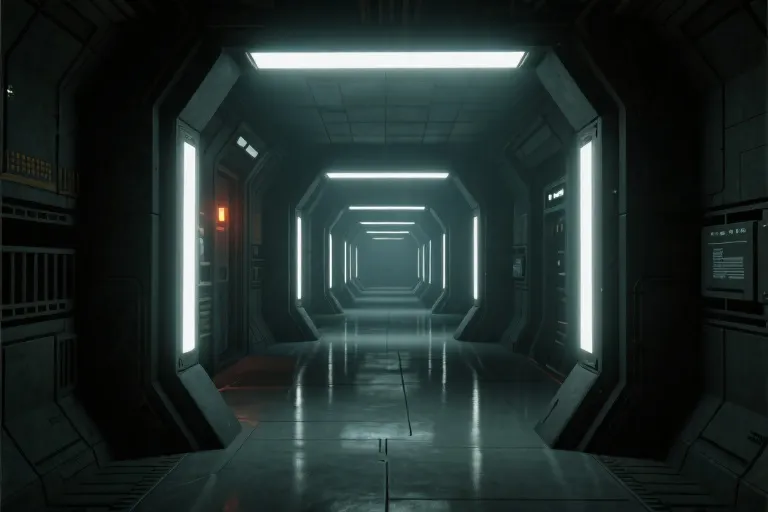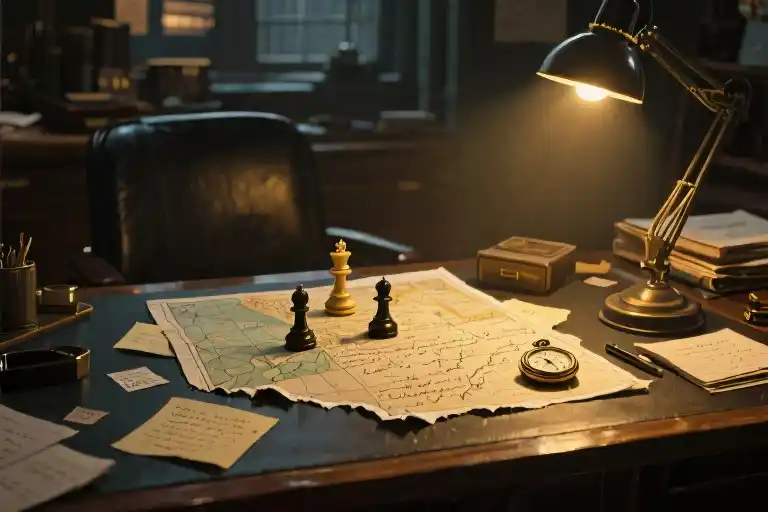The twin suns of Tatooine fade into surveillance monitors as Star Wars undergoes its most radical transformation. In 1977, Luke Skywalker’s hopeful gaze toward the horizon defined a generation’s storytelling expectations. Forty-five years later, Cassian Andor’s weary eyes tracking Imperial security cameras redefines them. This is the paradox at Andor’s core: a Star Wars story that systematically removes lightsabers, Force-wielders, and chosen one narratives yet achieves the franchise’s highest MetaCritic score (74 vs. Mandalorian’s 70).
What unfolds between these two iconic moments reveals more than just evolving cinematography. The visual contrast encapsulates Andor’s narrative rebellion – where traditional Star Wars’ mythic heroism gives way to grounded resistance. Director Tony Gilroy trades desert planet vistas for claustrophobic corporate corridors, swaps destiny-laden dialogue for bureaucratic doublespeak, and replaces the Force’s spiritual certainty with the messy calculus of revolution.
The numbers tell a compelling story. While maintaining 96% critic approval on Rotten Tomatoes, Andor attracted quieter but more passionate fan engagement. Its audience score (84%) trails The Mandalorian (93%), yet sparks fiercer analytical discourse – a telling indicator of its depth-over-breadth appeal. Nielsen ratings show smaller but more dedicated viewership, with episodes gaining 30-40% in delayed viewing versus other Star Wars series’ 15-20% bumps. This data paints a portrait of a show that rewards patience and close reading, breaking the franchise’s usual binge-and-forget consumption pattern.
At its heart, Andor poses a radical question: Can Star Wars mature beyond its own mythology? The answer emerges through three seismic shifts:
- Narrative Gravity: Where traditional Star Wars orbits around Jedi, Andor explores how ordinary people bend under Imperial oppression
- Moral Optics: Binary good vs. evil gives way to ethical fog – intelligence officers debate terrorism while rebels commit cold-blooded murder
- Temporal Reality: Epic space battles are replaced by the slow burn of bureaucratic oppression and meticulous rebellion planning
Gilroy’s genius lies in using Star Wars’ established iconography against itself. The Imperial insignia no longer marks cartoonish villains, but institutionalized evil in crisp white uniforms. Stormtroopers become terrifying not through blaster accuracy, but through their faceless systemic violence. This deliberate subversion creates something unprecedented: a Star Wars story that feels urgently contemporary while expanding the universe’s dramatic possibilities.
The series’ opening sequence perfectly encapsulates this approach. Instead of star destroyers or lightsaber duels, we witness Cassian navigating a corporate mining colony’s red tape – a mundane yet sinister introduction to life under the Empire. This establishes Andor’s central thesis: true tyranny isn’t about Death Stars, but about the daily erosion of dignity. When the inevitable rebellion comes, it carries weight because we’ve felt the boot pressing down, not just seen its shiny surface.
The Three Fracture Lines in Star Wars Storytelling
For decades, Star Wars operated on narrative autopilot – the Jedi-centric mythology, clear-cut morality plays, and destined hero’s journey formed its storytelling DNA. Then came Andor, wielding narrative thermal detonators that shattered these foundations with calculated precision. This isn’t just another flavor of blue milk; it’s a complete molecular restructuring of what Star Wars storytelling can be.
The Collapse of Jedi-Centrism: From Force Awakening to System Awakening
The absence of lightsabers in Andor isn’t an oversight – it’s a manifesto. Where traditional Star Wars measures conflict through kyber crystal glows (lightsaber battles between Jedi and Sith), Andor documents institutional oppression through flickering fluorescent lights in Imperial offices and prison blocks. The revolutionary act here isn’t deflecting blaster bolts with a lightsaber, but stealing payroll data from a corporate terminal. This shift from mystical chosen ones to systemic resistance creates something radical: a Star Wars story where change requires collective action rather than singular heroes.
Consider the visual grammar: instead of Tatooine’s twin suns symbolizing individual destiny, we get the artificial glare of Coruscant’s surveillance cameras representing omnipresent control. The ‘Force’ in this narrative isn’t a mystical energy field, but the crushing weight of bureaucratic machinery – shown through endless forms, identity checks, and the terrifying banality of Imperial middle managers like Supervisor Dedra Meero.
Moral Spectrum’s Gray Zone: Assassin Protagonists and ‘Noble’ Imperials
Andor performs narrative alchemy by making its Rebel spy protagonist commit cold-blooded murder in the opening act, while granting Imperial officers nuanced motivations. Security Inspector Karn isn’t a cackling villain but a striver trapped in the system’s gears – his tragic pursuit of validation mirroring Cassian’s own journey. This moral ambiguity reaches its zenith in the Aldhani heist, where both Rebels and Imperials display courage and cruelty in equal measure.
The show’s genius lies in making us question traditional Star Wars morality:
- Is killing for a cause different from killing for order?
- Can a Rebellion stay righteous when using terrorist tactics?
- Do ‘good guys’ exist when every character has blood on their hands?
Through characters like Luthen Rael – an antiquarian by day, rebel spymaster by night – Andor proves the most dangerous weapons aren’t blasters or lightsabers, but the compromises we rationalize.
Deconstructing the Hero Myth: Cassian’s Five Failed Missions
Traditional Star Wars heroes follow the Campbellian monomyth: call to adventure, supernatural aid, triumphant return. Cassian Andor’s journey reads like an anti-checklist of these tropes:
- Failed Extraction (Childhood): Leaves home as collateral damage rather than chosen one
- Botched Assassination (Pilot Episode): Kills the wrong man in his quest for vengeance
- Aborted Escape (Aldhani): Nearly gets his team killed through impulsive decisions
- Prison Survival (Narkina 5): Wins freedom through collective action, not solo heroics
- Reluctant Recruitment (Season Finale): Joins the Rebellion not from idealism, but exhausted pragmatism
This deliberate subversion creates something rare in Star Wars – a protagonist whose greatest strength isn’t special lineage or Force sensitivity, but sheer stubborn survival instinct. When Cassian finally declares “I’ll join the cause,” it carries more weight than any heroic monologue because we’ve seen every scar and compromise that led him there.
What emerges from these narrative fractures isn’t a broken story, but a liberated one. By dismantling Star Wars’ sacred cows, Andor didn’t abandon the galaxy far, far away – it gave us adulthood eyes to see its true scale and stakes. The revolution won’t be televised with lightsaber flourishes, but whispered in ration lines and fought in data rooms. And somehow, that makes it more Star Wars than ever.
The Four Pillars of Rebellion Narrative
Temporal Density Revolution: Character Transformations in Three Episodes
Traditional Star Wars storytelling often relies on seasonal arcs to develop characters, but Andor compresses profound transformations into mere episodes. The Narkina 5 prison sequence demonstrates this brilliantly – within three installments, we witness Cassian’s metamorphosis from self-interested survivor to conscious rebel. This narrative density creates a relentless momentum that mirrors the urgency of real revolutionary movements.
Key techniques enabling this:
- Compressed Timeline: The show’s meticulous chronology (each episode covering 1-3 days)
- Environmental Storytelling: The prison’s industrial machinery becomes a character itself
- Behavioral Nuances: Subtle shifts in body language telegraph internal changes
Spatial Oppression Systems: From Cubic Prisons to Glass Headquarters
Andor‘s production design serves as visual political commentary. Contrast the claustrophobic Narkina 5 prison cubes with the ISB’s transparent headquarters – both represent different facets of imperial control through architecture:
| Location | Oppression Method | Visual Metaphor |
|---|---|---|
| Narkina 5 | Physical confinement | Industrial dehumanization |
| ISB HQ | Panopticon surveillance | Bureaucratic transparency as control |
This spatial storytelling reaches its zenith in Episode 10’s prison break, where the very structure of the facility dictates the rebellion’s rhythm.
Linguistic Violence: The Paper Bullets of Empire
The Empire’s bureaucratic language forms its own weapon system. Notice how:
- Security ordinances use passive voice to obscure agency
- Performance metrics redefine human worth
- Memorandums sanitize violence through clinical terminology
These verbal strategies mirror real-world authoritarian regimes’ manipulation of language. The show’s attention to document design (font choices, form layouts) adds disturbing verisimilitude to this linguistic oppression.
Ensemble Dynamics: Twelve Hands on the Rebel Wheel
Breaking from Star Wars’ typical focus on chosen ones, Andor constructs a distributed narrative network:
- Interlocking Motivations: Luthen’s pragmatism vs. Vel’s idealism
- Asymmetric Knowledge: Mon Mothma’s political maneuvering unknown to ground operatives
- Collateral Damage: Minor characters like Kino Loy becoming unwitting catalysts
This narrative approach mirrors actual resistance movements – decentralized, messy, and dependent on unpredictable human elements. The show’s willingness to let key developments hinge on minor characters (like the Aldhani heist’s imperial driver) creates unprecedented realism for the franchise.
What emerges is a storytelling matrix where:
- Time becomes a pressurized force
- Spaces actively participate in the drama
- Language carries lethal consequences
- No single hero holds narrative dominance
This structural boldness explains why Andor‘s rebellion feels palpably dangerous in ways the Star Wars universe hasn’t shown us before. The show doesn’t just tell us about resistance – it makes us experience its operational realities through every cinematic element.
The Mirror Maze of Real-World Politics
What makes Andor truly exceptional in the Star Wars pantheon isn’t just its narrative audacity—it’s how Tony Gilroy’s writing team weaponizes science fiction to hold up a funhouse mirror to contemporary geopolitics. The show’s revolutionary cadence doesn’t echo in a galaxy far, far away; it pulses through our morning newsfeeds with unsettling familiarity.
Rebellion’s Fractured Idealism
The ideological civil war between Saw Gerrera’s extremists and Luthen Rael’s pragmatists plays like a masterclass in political theater. When Luthen coldly declares “We’ve all done terrible things on behalf of the Rebellion”, we’re not hearing space opera dialogue—we’re listening to the whispered confessions of every revolutionary movement from the French Resistance to modern activist circles. The show’s genius lies in depicting how moral compromises metastasize:
- The Paradox of Radicalization: Saw’s Partisans mirror real-world splinter groups who believe mainstream resistance has grown complacent
- The Bureaucracy of Revolution: Mon Motha’s political maneuvering in Coruscant’s senate chambers evokes NGO lobbying tactics
- The Currency of Trust: Vel’s cell structure operations demonstrate how insurgencies monetize relationships over firepower
This isn’t just world-building—it’s a forensic examination of how idealistic movements calcify into institutional power structures. The Coruscant protest sequences in Episode 12 could be lifted straight from 2020’s global unrest, complete with identical crowd control tactics and media blackouts.
Legislative Dystopia in Plain Sight
The Imperial Security Bureau’s Public Order Resentencing Directive should feel absurd in its bureaucratic villainy. Yet when Dedra Meero coolly explains how “three identical arrests constitute a pattern requiring mandatory sentencing”, American viewers will recognize the ghost of three-strikes laws that fueled mass incarceration. The show’s legislative horror manifests through:
| Star Wars Fiction | Earth Reality |
|---|---|
| Imperial Enhanced Data Security Act | Patriot Act’s Section 215 |
| Voluntary work quotas on Narkina 5 | Prison-industrial complex labor |
| Deniability protocols for rebel torture | Extraordinary rendition programs |
Gilroy’s writers embed these parallels not as heavy-handed allegories, but as the mundane paperwork of tyranny—the true banality of evil lies in triplicate forms and subcommittee approvals.
The Neoliberal Jailers
Nowhere is Andor‘s real-world commentary more devastating than in its depiction of middle-management villains. Supervisor Seyn Kahdra on Narkina 5 isn’t some cackling Sith Lord—he’s the living embodiment of late-stage capitalism’s dehumanization:
- Performance Metrics as Morality: His “Shift yields determine meal portions” policy mirrors gig economy algorithms
- The Illusion of Choice: Prisoners volunteering for dangerous tasks echoes precarious labor conditions
- Bureaucratic Sadism: His clipboard inspections weaponize corporate compliance culture
When Kahdra lectures prisoners about “the privilege of work”, the line could be lifted from any Silicon Valley hustle culture manifesto. This is oppression stripped of dramatic force lightning—just Excel spreadsheets and productivity quotas grinding souls into paste.
The Radical Honesty
What ultimately makes Andor‘s political commentary resonate is its rejection of simple answers. The show forces viewers to sit with uncomfortable questions:
- Is Luthen’s “I burn my life to make a sunrise I know I’ll never see” noble or pathological?
- Does Dedra Meero’s competence make her more terrifying than Vader?
- Can a rebellion built on lies (like Kreegyr’s sacrifice) remain morally just?
These aren’t hypothetical Star Wars debates—they’re the same dilemmas facing every activist movement from climate change organizers to democratic reformers. By holding its audience in this discomfort, Andor achieves what no lightsaber duel ever could: making the Star Wars galaxy feel dangerously, urgently real.
The Anatomy of Creative Courage
Behind Andor’s groundbreaking departure from traditional Star Wars storytelling lies a fascinating case study in creative risk-taking. Showrunner Tony Gilroy didn’t just break the rules – he had to first convince the galaxy’s most cautious corporate entity to let him do it.
The “No Lightsabers” Pitch
In multiple interviews, Gilroy revealed how he framed Andor’s radical approach as an asset rather than a liability. “We positioned it as premium political thriller that happens to exist in the Star Wars universe,” he explained to The Hollywood Reporter. The key was demonstrating how removing Force-wielders and space wizards could actually expand the franchise’s storytelling palette. Early concept art deliberately emphasized gritty, earth-toned environments rather than the usual gleaming starships and exotic aliens.
This strategic framing tapped into Disney’s desire to attract prestige TV audiences beyond core Star Wars fans. By highlighting parallels to critically acclaimed dramas like The Americans rather than typical sci-fi fare, Gilroy made the unconventional approach seem commercially viable.
Rogue One as Proof of Concept
The 2016 film’s $1 billion box office became Gilroy’s secret weapon. As co-writer of the theatrical release and director of reshoots, he could point to concrete evidence that darker, more grounded Star Wars stories had mass appeal. Internal memos reportedly emphasized how Rogue One’s third-act intensity (particularly the now-iconic Darth Vader hallway scene) proved that audiences would embrace morally complex characters when executed well.
Interestingly, the film’s success with both critics (84% on Rotten Tomatoes) and general audiences (A- CinemaScore) created permission to go even further with Andor. Where Rogue One still included familiar elements like Jedi lore and comedic droids, the series would strip these away completely.
Managing Fan Expectations
Marketing played a crucial role in preparing audiences for Andor’s differences. The first teaser trailer conspicuously avoided any footage resembling traditional Star Wars – no lightsaber ignitions, no alien cantinas, no mentions of the Force. Instead, it focused on Cassian’s morally ambiguous spy work and the oppressive weight of Imperial bureaucracy.
This careful expectation-setting continued through press tours, with Gilroy and star Diego Luna repeatedly emphasizing phrases like “adult Star Wars” and “political thriller.” By the time the series premiered, even casual fans understood this wasn’t going to be another Mandalorian-style adventure.
The Corporate Tightrope Walk
Perhaps most impressively, Gilroy’s team navigated Disney’s notoriously risk-averse culture by building safeguards into their creative process:
- Budget Justifications: Designed visually striking but cost-effective sets that reused locations in clever ways
- Episode Blueprinting: Created detailed season-long outlines to assure executives the unconventional structure had narrative payoff
- Talent Anchors: Cast respected actors like Fiona Shaw and Stellan Skarsgård to lend credibility
This balanced approach allowed Andor to become what Vanity Fair called “the first Star Wars project that feels like it was made by adults, for adults” while still fitting within corporate parameters. The result? A second season greenlight before the first even finished airing – rare validation in today’s volatile streaming landscape.
The Ultimate Star Wars Paradox: When Fiction Feels More Real
The closing moments of Andor’s first season finale linger like the aftertaste of a strong caf – bitter, awakening, and impossible to ignore. As the camera pulls back from Cassian’s determined gaze aboard the rebel ship, we’re left with something unprecedented in Star Wars history: not the satisfaction of a hero’s journey completed, but the uneasy anticipation of revolutions to come. This finale encapsulates the show’s boldest achievement – proving that a galaxy far, far away can hold up the sharpest mirror to our own world.
Decoding Season Two’s Political Blueprint
Those frame-by-frame trailer breakdowns circulating the holonet aren’t just fan service – they’re revealing Gilroy’s continued commitment to real-world parallels. Notice how the Imperial security council scenes mirror contemporary war room aesthetics down to the cold lighting? Or how the labor strikes on Segra Milo carry distinct echoes of 2020’s essential worker movements? The genius lies in never making these connections explicit – like all great political fiction, Andor trusts its audience to recognize the patterns.
What truly excites about the upcoming season isn’t whether Cassian will eventually appear in Rogue One (we know he will), but how the show might tackle:
- The manufacturing of consent through media (ISB’s propaganda machine)
- The privatization of war (corporate sector’s growing role)
- Revolution’s moral compromises (Luthen’s “I burn my life” speech foreshadowing)
Why Authentic Fiction Hits Harder
There’s an beautiful irony in how Andor’s grounded approach makes its Star Wars moments more impactful. When that TIE fighter finally screams across the screen in episode 6, the effect isn’t diluted by constant fan service – it’s electrifying because we’ve earned it through three hours of political buildup. This creates the show’s central paradox: by removing the mystical elements, the remaining Star Wars iconography gains new power.
Consider how these traditionally “un-Star Wars” elements actually deepen our connection to the universe:
- Bureaucratic Evil: Watching mid-level Imperial officers debate resource allocation makes the Empire feel terrifyingly real
- Revolutionary Logistics: Seeing rebels argue over funding and supply lines adds weight to eventual battles
- Silent Protests: The prison arc’s visual storytelling communicates more than any lightsaber duel could
Your Turn to Rewrite the Rules
As we await season two, here’s an invitation to reshape the galaxy: What Star Wars convention would you retire to make room for more Andor-style storytelling? Is it:
- [ ] The chosen one prophecies
- [ ] Planet-destroying superweapons
- [ ] Black-and-white morality
- [ ] Jedi-centric narratives
Drop your vote in the comments, and let’s continue Andor’s most radical lesson – that Star Wars grows stronger when we challenge its traditions. Because in the words of a certain rebel spy: “That’s what a reckoning sounds like.”





